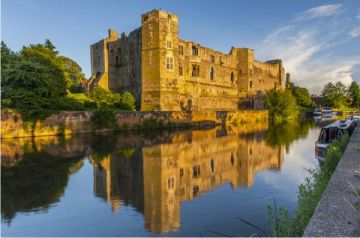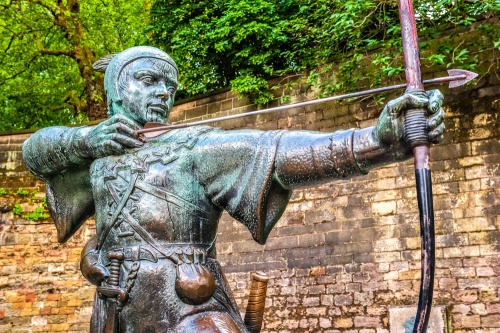
One of Nottingham's most popular visitor attractions is a modern statue of the outlaw Robin Hood, which stands on a small green space known as Robin Hood's Lawn in what used to be the moat of medieval Nottingham Castle. The statue shows the famous outlaw, his bow bent, an arrow notched and ready to fire, aiming in the general direction of the twin-towered castle gatehouse.
Robin Hood at Nottingham Castle
There is, unfortunately, no definitive history of Robin Hood, nor do we even know if he was a real person or if so, when he lived. What we do have are collections of tales that have been altered and added to over the centuries. One of these stories says that Robin Hood was captured by his enemy, the wicked Sheriff of Nottingham, and held prisoner in Nottingham Castle.
The ever-resourceful Robin managed to escape through the caves and underground tunnels that permeate Castle Rock, the rocky promontory on which the castle stands. He made his way to safety in Sherwood Forest. The escape is certainly plausible; we know that the system of caves and tunnels were in place before the castle was built in the 11th century. And we also know that the caves were used by Edward III and his supporters in 1330 to steal into the castle at night and capture Edward's enemy, Roger Mortimer.
You can follow in Edward III's footsteps - and maybe in the footsteps of Robin Hood himself - and tour the caves and tunnel network under the castle.
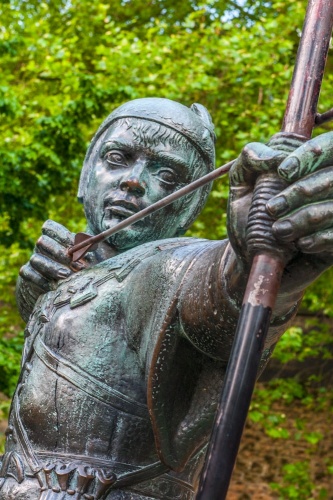
The Archery Competition
Another story connects the town of Nottingham and the outlaw. According to legend, the Sheriff of Nottingham determined to capture Robin Hood by holding an archery competition in Nottingham. He was certain that Robin would not be able to resist showing off his archery skills and he had men waiting to catch him if he dared to compete. Robin suspected the plot and had himself disguised as a one-eyed, bearded farmer.
Robin won the competition, shooting his last arrow sp perfectly true that it split his opponent's arrow in half and hit the bullseye. The Sheriff awarded the disguised Robin a golden arrow as a prize. He was sitting down to dinner that evening, gloating that Robin Hood had been too cowardly to attend the competition, when an arrow flew through an open castle window and landed on the table in front of the startled Sheriff. a note attached to the arrow thanks him for the golden arrow and was signed 'Robin Hood'.
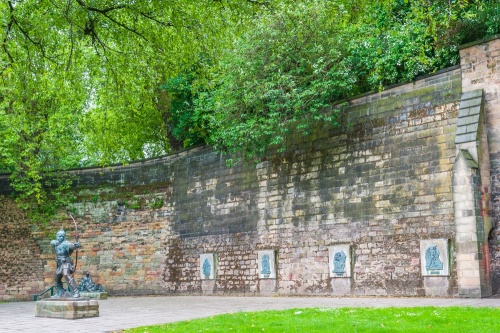
The Statue
The statue is greater than life-sized, standing 7 feet tall and set upon a rusticated stone plinth. It was sculpted by local artist James Arthur Woodford RA, OBE (1893-1976) and erected in 1952. It weighs over half a ton and is made up of 8 separate pieces of bronze. Woodford wanted to ensure that the statue was as authentic as possible and went to great lengths to research the stories of Robin Hood, period costume, and archery so that the finished sculpture would look as real as it possibly could.
The statue was a gift to the city by businessman Philip EF Clay, who wanted to give Nottingham a focal point for visitors interested in the town's links to the legend of Robin Hood. Clay gave £5,000 for the statue and complementary plaques. He wanted to make his gift anonymously, but the city council talked him out of it and honoured him by name during the unveiling ceremony.
The sculpture was commissioned in 1949 to mark the visit to Nottingham of their royal highnesses the Princess Elizabeth (now Queen Elizabeth II) and the Duke of Edinburgh in honour of the town's official 500th anniversary.
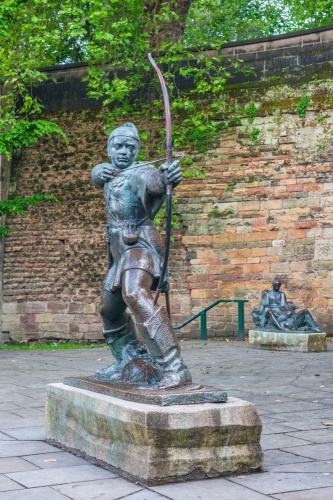
The location outside the castle walls is intentional; it represents Robin Hood's role as an outsider, an opponent of the establishment. If Clay's intention was to provide a focal point for visitors he certainly succeeded; most visitors to Nottingham head for the statue and have their photo taken beside it. And it isn't just visitors to Nottingham that have their photos taken here; famous local celebrities do the same, among them the legendary Nottingham Forest football manager Brian Clough.
The Robin Hood statue is just a part of a group of sculptures on Robin Hood's Lawn. Set against the bank behind the statue are plaques illustrating tales from the legend of Robin Hood, along with smaller sculptures of some of his band of Merry Men, including Little John, Friar Tuck, Alan a' Dale, and Will Scarlett.
The Plaques
There are 4 plaques set into the Castle's outer bailey wall. One depicts Robin Hood, Maid Marian and Friar Tuck fighting Guy of Gisborne’s men, the second shows Richard the Lionheart joining the hands of Maid Marian and Robin Hood as a symbol of marriage, the third shows the famous fight between Robin Hood and Little John as they cross a river, and the fourth plaque shows a dying Robin Hood shooting his final arrow to mark his burial site.
The sculptural group was unveiled by the Duchess of Portland on 24 July 1952.
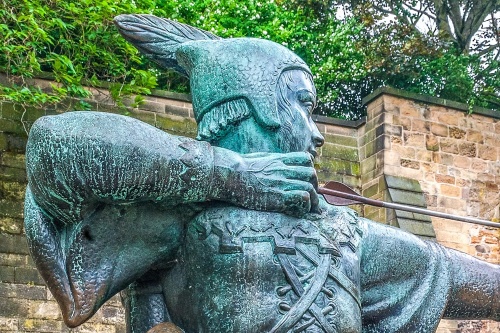
Unfortunately, the statue has been vandalised several times in recent years. The lower half of the bow was broken off at least 4 times, most recently in July 2018.
The statue has been awarded a Grade II listed status by Historic England in recognition of its heritage value.
About the Sculptor
James Woodford also sculpted the fountain of the British Medical Association House (listed Grade II*). Woodford had a fascinating life; he was the son of a lace designer and studied at Nottingham School of Art before joining the 11th Sherwood Foresters in WWI. After the war, he attended the Nottingham School of Art (1919-1920).
An ex-Serviceman's grant allowed him to study at the Royal College of Art (1920-1921). In 1922 he was awarded the Prix de Rome in sculpture. He had a long career specialising in sculpting heraldic objects. The highlight came in 1953 when he was commissioned to sculpt ten 6-foot high 'Queen's Beasts' to line the approach to Westminster Abbey for the Coronation of Elizabeth II. He was awarded an OBE in 1953.
Getting There
The statue stands on Robin Hood's Lawn, off Castle Place, immediately below the twin-towered entrance gates of Nottingham Castle. The castle is well-signposted from central Nottingham and is very easy to find.
About Robin Hood Statue, Nottingham
Address: Robin Hood's Lawn, Castle Place, Nottingham,
Nottinghamshire,
England, NG1 6EL
Attraction Type: Historic Building - Landmark
Location: Immediately below the entrance to Nottingham Castle, off Castle Place
Website: Robin Hood Statue, Nottingham
Location
map
OS: SK569395
Photo Credit: David Ross and Britain Express
POPULAR POSTS
HERITAGE
 We've 'tagged' this attraction information to help you find related historic attractions and learn more about major time periods mentioned.
We've 'tagged' this attraction information to help you find related historic attractions and learn more about major time periods mentioned.
Find other attractions tagged with:
NEARBY HISTORIC ATTRACTIONS
Heritage Rated from 1- 5 (low to exceptional) on historic interest
Nottingham Castle - 0.1 miles (Castle) ![]()
Museum of Nottingham Life at Brewhouse Yard - 0.1 miles (Museum) ![]()
Nottingham, St Peter's Church - 0.2 miles (Historic Church) ![]()
National Justice Museum - 0.4 miles (Museum) ![]()
Nottingham, St Mary's Church - 0.4 miles (Historic Church) ![]()
Wollaton Hall and Natural History Museum - 2.3 miles (Historic House) ![]()
Holme Pierrepont Hall - 3.7 miles (Historic House) ![]()
Strelley, All Saints Church - 4.2 miles (Historic Church) ![]()
Nearest Holiday Cottages to Robin Hood Statue, Nottingham:
Ilkeston, Derbyshire
Sleeps: 4
Stay from: £418 - 1241
More self catering near Robin Hood Statue, Nottingham



